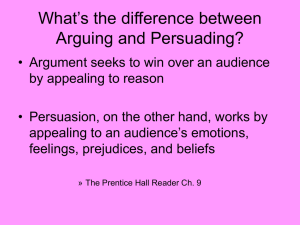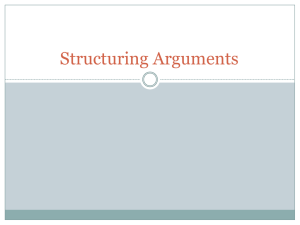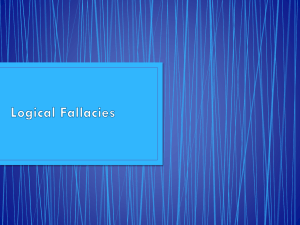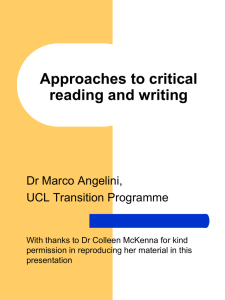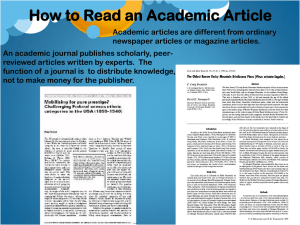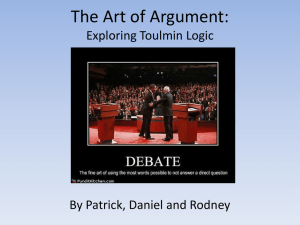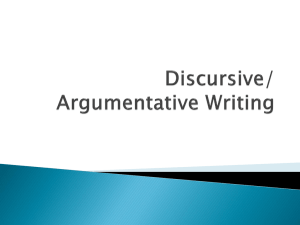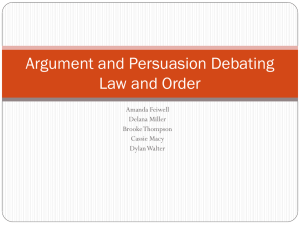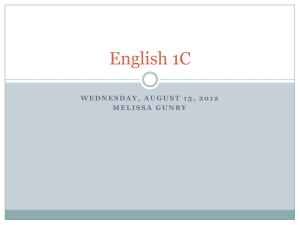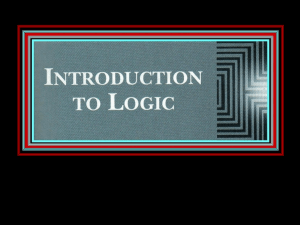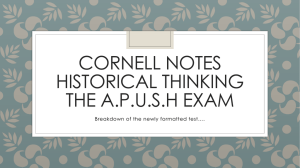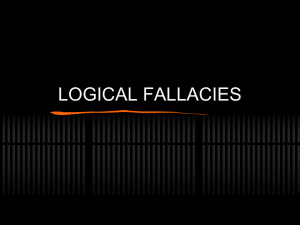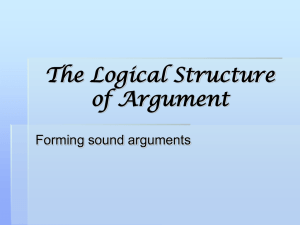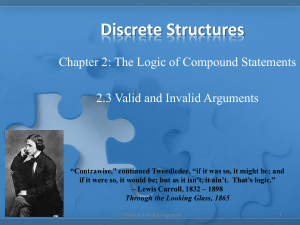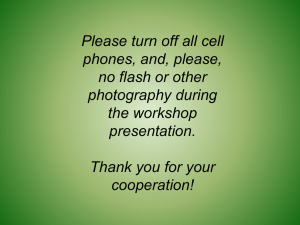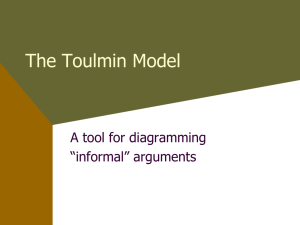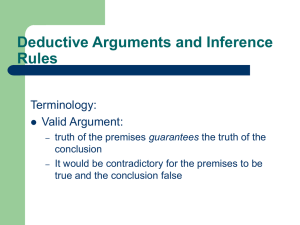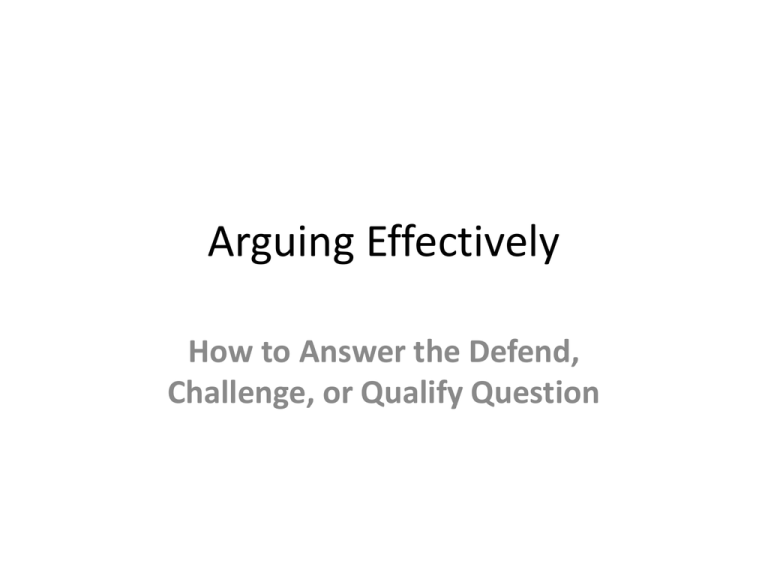
Arguing Effectively
How to Answer the Defend,
Challenge, or Qualify Question
WHAT STUDENTS KNOW (OR DON'T
KNOW) ABOUT ARGUMENT
•
•
•
•
•
•
•
•
Students sometimes confuse argument with debate, taking a strong, oppositional
position on a topic and then trying to "win" points.
Students sometimes conceptualize an argument as a fight: they spar with a text
without taking the time to understand it.
Students sometimes think in black and white, neglecting the nuances of an
argument.
Students sometimes jump on the first bandwagon they find, citing an authority
with almost blind reverence and ignoring all other points of view.
Students can mistake argument for opinion, writing papers that are subjective and
self-gratifying rather than objective and reader-based.
Students sometimes construct a weakly supported or poorly reasoned argument
because it is, after all, their opinion, and they have a right to it.
Students can find themselves overwhelmed by the complexity of an intellectual
problem, unable to take a stand.
Students too often rely on structures that they learned in high school (for instance,
the five-paragraph theme), thereby crippling their arguments from the get-go.
ELEMENTS OF CRITICAL THINKING
•
•
•
•
•
Observations. From a series of observations, we can come to establish:
Facts. From a series of facts, or from an absence of fact, we make:
Inferences. Testing the validity of our inferences, we can make:
Assumptions. From our assumptions, we form our:
Opinions. Taking our opinions, we use evidence and the principles of logic
to develop:
• Arguments. And when we want to test our arguments and to challenge
the arguments of others, we employ:
• Critical Analysis (through which we challenge the observations, facts,
inferences, assumptions, and opinions in the arguments that we are
analyzing).
The process is not linear; rather, as we go about establishing our opinions and
crafting our arguments, we return to our observations and facts, drawing
new inferences and forming new assumptions that, in turn, affect the
arguments that we are trying to make.
ELEMENTS OF ARGUMENT: THESIS,
EVIDENCE, REASON
• THESIS- a thesis sentence declares, focuses,
and organizes an argument. But how do you
craft one which is truly effective?
Thesis Mistakes
• Misreading the prompt: .They may make a
thinking mistake and craft a thesis sentence that
declares an observation rather than an argument
• Creating a formulaic thesis-i.e., sentences that
state a claim and then offer a list of (usually
three) illustrations—not understanding that a
thesis can point to conflicting claims or raise a
question
• Poorly written thesis-poor sentences, burying
important ideas in subordinate clauses, thereby
vexing the reader.
Examples of Good and Bad Theses
• Student writing samples
Evidence
• Example: You’ve been assigned to write an essay that
contrasts the river and shore scenes in Mark Twain’s
Huckleberry Finn. You work on it for several days,
producing three versions of your thesis:
• Version 1: There are many important river and shore
scenes in Huckleberry Finn.
• Version 2: The contrasting river and shore scenes in
Huckleberry Finn suggest a return to nature.
• Version 3: Through its contrasting river and shore
scenes, Twain's Huckleberry Finn suggests that to find
the true expression of American democratic ideals, one
must leave "civilized" society and go back to nature.
Discussion
Let’s consider the word choice issues in these statements.
In Version 1, the word "important"—like
"interesting"—is both overused and vague; it suggests
that the author has an opinion but gives very little
indication about the framework of that opinion. As a
result, your reader knows only that you’re going to talk
about river and shore scenes, but not what you’re
going to say. Version 2 is an improvement: the words
"return to nature" give your reader a better idea where
the paper is headed. On the other hand, she still does
not know how this return to nature is crucial to your
understanding of the novel
Discussion of Thesis (cont.)
• Finally, you come up with Version 3, which is a
stronger thesis because it offers a sophisticated
argument and the key terms used to make this
argument are clear. At least three key terms or
concepts are evident: the contrast between river
and shore scenes, a return to nature, and
American democratic ideals.
• By itself, a key term is merely a topic—an element
of the argument but not the argument itself. The
argument, then, becomes clear to the reader
through the way in which you combine key terms.
Using the Toulmin Model in AP
• Definitions:
• Rhetoric: Is rhetoric the use of language to mislead or
manipulate, as popular use would have it, or is it “the
use of language as a symbolic means of inducing
cooperation,” as Kenneth Burke says?
• Argument: Is argument a conflict in language, a contest
between opposing verbal forces, a discussion involving
disagreement, a contentious or disputatious quarrel, or
is it rather a process of reasoned inquiry, of rational
discourse seeking mutual ground? If the latter, then we
engage in argument whenever we think clearly about
the world.
The Key to Successful Argument
• Students need to engage the audience,
encouraging the reader to consider the
positions they present as reasonable and
perhaps valuable, in a voice felt as reasoned,
trustworthy, and honorable, using the classic
appeals to logos, pathos, and ethos.
• **the reasonable voice is usually a qualified
one
Creating a Reasonable Argument
• Nearly all effective arguments are qualified
ones.
• Students need not only to anticipate
objections to their positions but also to
recognize and respect complexity itself. A
reasonable voice sees not two sides to an
issue but multiple perspectives, and that voice
presents an argument as the conclusion of a
logical process.
Problematic Points of View
• Why are these examples problematic?
• “Senior year is a complete waste of time”.
• “Sontag’s position is stupid”.
Three Types of Argument
• Arguments of fact state that something is or is not the case.
Causal arguments say that one event or condition leads to another
or is likely to. For example:
• Arguments of value state that something is or is not desirable.
They involve evaluations of quality or worth according to accepted
criteria. For example,
• Arguments of policy state that something should or should not be
done. They make recommendations for practice or
implementation. FOR EXAMPLE:
This kind of argument will naturally contain components—often
included as support—of those of fact and value, as my final
example in each category illustrates.
The Toulmin Model
• Its components are as follows:
• A claim is an assertion. It should seem a
“conclusion whose merits we are seeking to
establish,” in Toulmin’s words, or “the conclusion
you reach after testing the evidence that
supports your belief,” as Kathleen Bell puts it in
Developing Arguments.
• The support consists of the data used as
evidence, reasons, or grounds for the claim.
• A warrant expresses the assumption necessarily
shared by the speaker and the audience.
The Toulmin Model, cont.
• Similar to the second premise of a syllogism, it serves as a
guarantee, linking the claim to the support.
• Backing consists of further assurances or data without
which the warrant lacks authority.
• A qualifier, when used (e.g., “usually,” “probably,” “in
most cases,” “most likely”), restricts the terms of the claim
and limits its range, indicating the degree of strength
delivered by the warrant.
• A reservation explains the terms and conditions
necessitated by the qualifier.
• A rebuttal gives voice to objections, providing the
conditions that might refute or rebut the warranted claim.
The Toulmin Diagram
Data________________________Backing
↑
↑
↑
Warrant Qualifier Reservation
↑
Backing
Toulmin Model con’t.
• Toulmin states it this way: Data, so (qualifier)
claim, since warrant, on account of backing,
unless reservation. A good classroom model is
that used by Annette Rottenberg and
Kathleen Bell and others: Because (data as
support), therefore, or so (qualifier?) (claim),
since (warrant), because, or on account of
(backing), unless (reservation).
Toulmin Argument Example
• Data (It is raining.)_______Claim (I should take
my umbrella.)
↑
↑
↑
Warrant
Qualifier
Reservation
(It will keep me dry.) (Probably.) (Unless it has a
hole in it.)
↑
Backing
(The material is impervious or waterproof.)
Importance of Word Choice in
Argument
• "Awkward," "vague," and "unclear" word choice
Sometimes a sentence is hard to follow because there is a grammatical
problem with it or because of the syntax (the way the words and
phrases are put together). Here's an example: "Having finished with
studying, the pizza was quickly eaten." This sentence isn't hard to
understand because of the words I chose—everybody knows what
studying, pizza, and eating are. The problem here is that readers
will naturally assume that first bit of the sentence "(Having finished
with studying") goes with the next noun that follows it—which, in
this case, is "the pizza"! It doesn't make a lot of sense to imply that
the pizza was studying. What I was actually trying to express was
something more like this: "Having finished with studying, the
students quickly ate the pizza." If you have a sentence that has
been marked "awkward," "vague," or "unclear," try to think about it
from a reader's point of view—see if you can tell where it changes
direction or leaves out important information.
Word Choice Problems
•
Misused words—the word doesn't actually mean what the writer thinks it does.
Example: Cree Indians were a monotonous culture until French and British settlers
arrived.
Revision: Cree Indians were a homogenous culture.
•
Words with unwanted connotations or meanings.
Example: I sprayed the ants in their private places.
Revision: I sprayed the ants in their hiding places.
•
Using a pronoun when readers can't tell whom/what it refers to.
Example: My cousin Jake hugged my brother Trey, even though he didn’t like him
very much.
Revision: My cousin Jake hugged my brother Trey, even though Jake doesn't like
Trey very much.
More Word Choice Problems
•
Jargon or technical terms that make readers work unnecessarily hard. Maybe you need to use
some of these words because they are important terms in your field, but don't throw them in just
to "sound smart."
Example: The dialectical interface between neo-Platonists and anti-disestablishment Catholics
offers an algorithm for deontological thought.
Revision: The dialogue between neo-Platonists and certain Catholic thinkers is a model for
deontological thought.
•
Loaded language. Sometimes we as writers know what we mean by a certain word, but we haven't
ever spelled that out for readers. We rely too heavily on that word, perhaps repeating it often,
without clarifying what we are talking about.
Example: Society teaches young girls that beauty is their most important quality. In order to prevent
eating disorders and other health problems, we must change society.
Revision: Contemporary American popular media, like magazines and movies, teach young girls that
beauty is their most important quality. In order to prevent eating disorders and other health
problems, we must change the images and role models girls are offered.
Wordiness No-Nos
I came to the realization that
I realized that
She is of the opinion that
She thinks that
Concerning the matter of
About
During the course of
During
In the event that
If
In the process of
During, While
Regardless of the fact that
Although
Due to the fact that
Because
In all cases
Always
At that point in time
Then
Prior to
Before
Word Choice- Avoiding Cliches
Cliches are not acceptable in academic writing,
as they are seen as trite, corny, or annoying.
Agree to disagree
Disagree
Dead as a doornail
Dead
Last but not least
Last
Pushing the envelope
Approaching the limit
Up in the air
Unknown, undecided
Play it by ear
? You try
Let the cat out of the bag
Repetition vs. Redundancy
• These two phenomena are not necessarily the same. Repetition can
be a good thing. Sometimes we have to use our key terms several
times within a paper, especially in topic sentences. Sometimes
there is simply no substitute for the key terms, and selecting a
weaker term as a synonym can do more harm than good. Repeating
key terms emphasizes important points and signals to the reader
that the argument is still being supported. This kind of repetition
can give your paper cohesion and is done by conscious choice.
• In contrast, if you find yourself frustrated, tiredly repeating the
same nouns, verbs, or adjectives, or making the same point over
and over, you are probably being redundant. In this case, you are
swimming aimlessly around the same points because you have not
decided what your argument really is or because you are truly
fatigued and clarity escapes you.
D2: Teen pregnancy can be used as a teaching tool to show the consequences of
unprotected sex
*One way to control unplanned pregnancies
*responsibility of taking care of a child will deter from future unplanned
pregnancies
*unplanned teen pregnancies can cause hardships; college plans, finances, stress
on family
*abortion possibilities miscarriage or medical issues of teen or unborn child can
cause emotional damage
Avoiding Redundancy
Teen Pregnancy
Rising rates of teen pregnancy in America proves that
birth control needs to become more readily available
for teenagers
Q:birth control is good but supports unprotected sex
D1: Birth control encourages teen sex
D2: Teen pregnancy can be used as a teaching tool to
show the consequences of unprotected sex
A: Birth control allows for safe sex and protects
against STD’s

